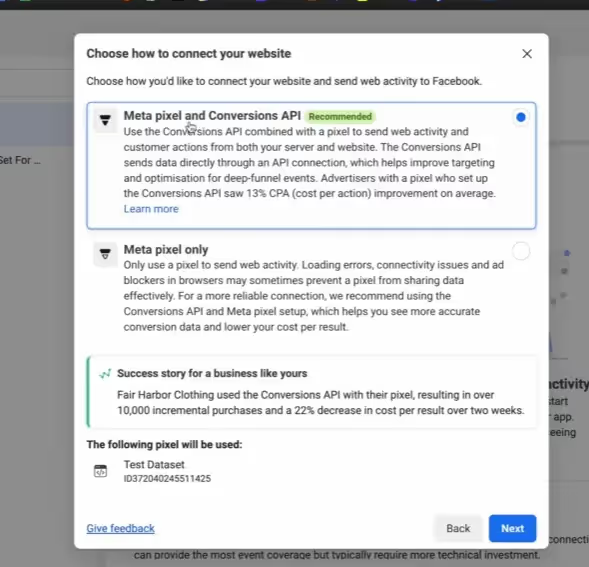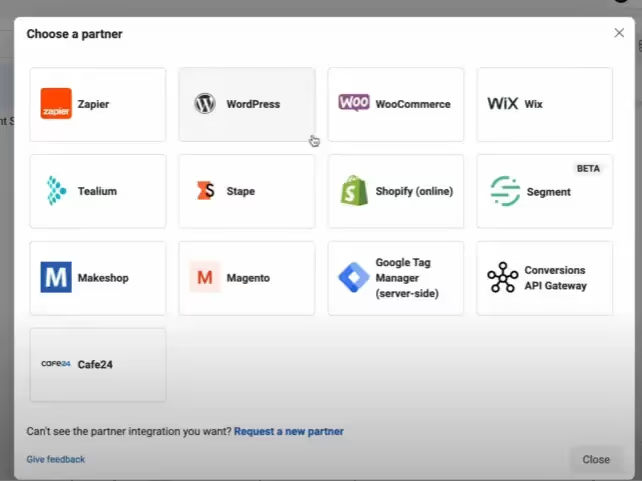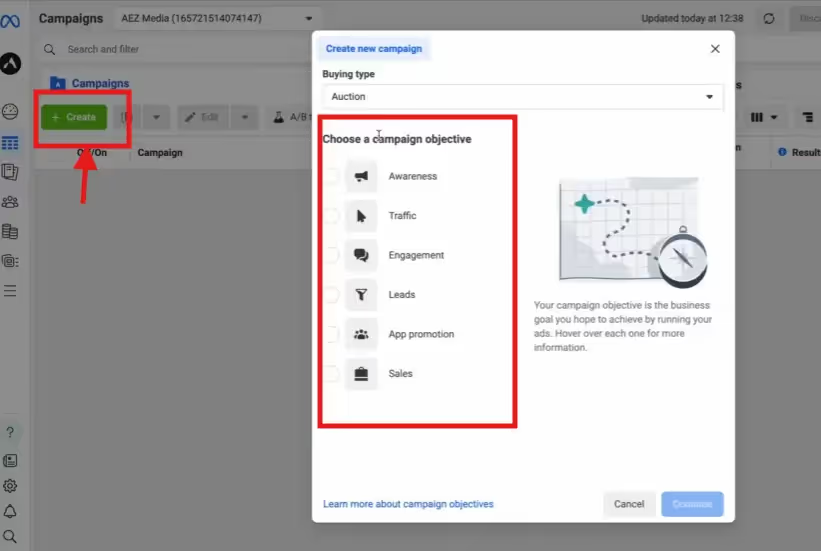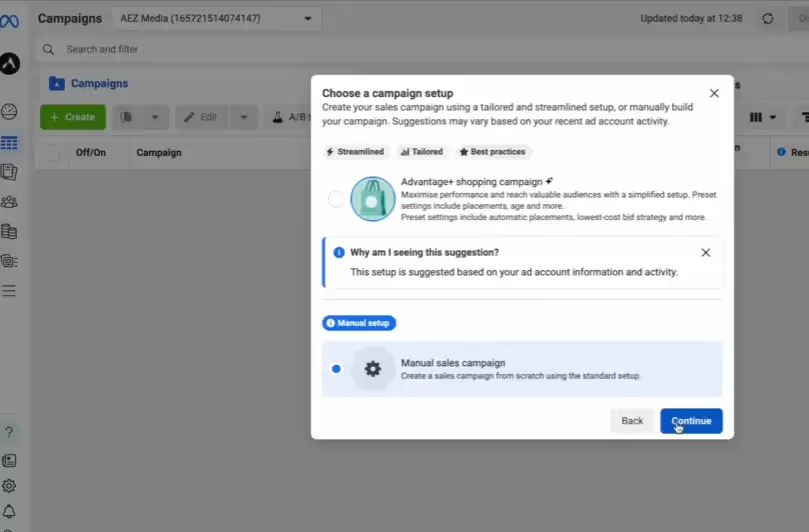We’re going to walk you through how to use the best Facebook ads dropshipping tactics. If it’s your first time working on your e-commerce ads strategy, then this guide is perfect for you. If you’ve ever wanted to run ads that convert and get sales, then this post is for you as well. You will avoid wasting budget, use Meta’s features like a pro, and build high-ROAS campaigns in no time. Let’s start.
How to Set Up Your E-Commerce Ads Strategy?

Before you start running Facebook ads, let's make one thing clear: You will have to set up a Facebook page for your dropshipping business. You can't drive organic traffic without building a solid community.
Here is how you get started:
- Log in to your Meta account and click on Pages from the left-hand menu
- Create New Page and type in your category, page name, and description. Choose e-commerce website for the page category.
- Upload your profile pic and cover photo
This finishes your basic setup. Next, you will need to create a Facebook Business Manager Account. You can go to the Facebook Business Manager Homepage and click on Create Account. Enter your business details, add your FB page, and create your ad account.
Sounds simple, yes?
Now for the next step, we'll need to create a Facebook Ads account. Go to Business Manager > Ad Accounts and click on Add. Create a new account, set a name, and pick your timezone and currency. Link your ad account to your FB page.
Installing Pixel

You'll need to install Meta Pixel to track user actions on your website. This will help optimize your Facebook ads for dropshipping and increase conversions.
Under Business Manager, click on Events Manager and select Connect Data Source. Select Web and choose Meta Pixel. You can name your Pixel datasets to reduce the need to build and manage multiple API integrations. Now you've got everything in one place.

For the last step, enter your website URL and click on "Check". Connect your website by selecting the "Meta pixel and Conversions API" option.

You can now choose your Integration platform. Go with Shopify if you want. Now you have everything ready to optimize your Facebook ads for dropshipping. You'll also be able to track important events like Purchase and Add to Cart.
How to Create a New Facebook Ads Campaign for Dropshipping

Here’s how:
- Open Ads Manager
- Go to the Campaigns tab and select Create
- Choose Campaign Objective
You can start with Engagement to check your audience's interest levels in the beginning and gauge it. Name your campaign and turn on Campaign Budget Optimization (CBO). This will allow Facebook to manage your budget better when it comes to allocating it to the best-performing ad sets.

In the Campaigns tab, you will find 11 different objectives. If your goal is to drive web traffic, choose brand awareness. You can also use the Facebook ads for dropshipping feature which is new. We like the Advantage + Shopping Campaign for automating the dropshipping process.
At the Campaign level, if you need to configure anything, you can do it under Special Ad Categories.
This covers the basics of how to get started with Facebook ads for dropshipping.
How to Track and Optimize Your Dropshipping Ad Performance?
After launching your Facebook ads for dropshipping campaigns, tracking performance becomes non-negotiable. Without proper monitoring, you're throwing money at ads with no clear understanding of what works and what drains your budget. Facebook offers robust analytics tools built directly into Ads Manager, and when combined with Meta Pixel data, you get a complete picture of campaign health.
Start by establishing key performance indicators (KPIs) that align with your business goals. Cost per purchase (CPP) tells you exactly how much you're paying to acquire each customer. Click-through rate (CTR) reveals whether your creative resonates with audiences. Conversion rate shows how many site visitors actually complete purchases. Return on ad spend (ROAS) provides the ultimate profitability metric.
Check your Ads Manager dashboard daily during the first two weeks of any new campaign. Look for patterns in hourly performance data to identify peak engagement times. Some products sell better during evening hours when people browse social media relaxing at home. Others perform during lunch breaks when workers scroll through feeds. Use this data to schedule ad delivery during high-converting windows.
Setting Up Custom Conversions
Custom conversions let you track specific actions beyond standard events like purchases and add-to-carts. Create custom conversions for product page views, newsletter signups, or even time spent on site. Navigate to Events Manager, select Custom Conversions, and click Create Custom Conversion. Define your URL rules and event parameters to track precisely what matters for your dropshipping store.
These custom metrics help refine audience targeting and ad optimization. When Facebook knows which actions lead to purchases, its algorithm prioritizes showing ads to users most likely to complete those actions. This improves your overall campaign efficiency and reduces wasted spend on low-intent audiences.
How to Manage Budget and Spend Limits for Meta Dropshipping Ads?
Many dropshippers lose thousands by allowing high-performing campaigns to run unchecked without budget guardrails. Set your daily budget 20-30% below what you're comfortable losing on a single day. If your supplier takes three weeks to ship products, you need enough runway to absorb ad costs without cashflow strain.
Create separate ad accounts for different product categories or seasonal campaigns. This compartmentalization prevents one underperforming category from draining budget allocated to winners. Your summer fashion ads won't cannibalize budget from your winter home décor campaigns when they operate independently. Track performance by account to identify which product lines generate the best ROAS and allocate budgets accordingly
Do weekly budget reviews regardless of campaign automation. Review your Ads Manager every Monday to verify spend aligns with your strategic plan. Look for unexpected cost increases, unusual frequency spikes, or performance drops.
Managing Cash Flow and Payback Periods
Calculate your payback period—the time between spending ad money and receiving customer payments. If you spend $1,000 on ads today but customers take 30 days to pay and your supplier needs 21 days to deliver, you're waiting 51 days minimum to recoup costs. Most dropshippers underestimate payback periods and exhaust capital scaling too aggressively.
Size your initial ad budget to cover at least three payback cycles of negative cash flow. If your payback period is 45 days and you're spending $500 daily, you need $67,500 in available cash before scaling. This buffer prevents borrowing at predatory rates or pausing profitable campaigns when cash temporarily runs dry.
Work backward from your profit margin to determine sustainable daily spend. If your average profit per order is $25 and your conversion rate is 2%, you need 50 ad clicks to generate one profitable sale. At $0.80 cost per click, that's $40 to acquire each $25 profit—unsustainable. Improve your metrics first or find higher-margin products before scaling ad spend beyond your profitability threshold.
Best Facebook Ads for Dropshipping Strategies in 2025

Here are the best strategies to use when it comes to making the most out of your Facebook ads for dropshipping:
Pick New Lookalike Audiences
Lookalike audiences are one of the best ways to find new customers by using Facebook ads. You can find this feature in the Facebook ads manager in your account. It's a great way to combat audience fatigue and not overspend your budget. A 3% to 5% lookalike audience is the sweet spot and can help you reach up to 5 to 10 million people.
Expand Location Targeting
The second trick up our sleeve is to find secondary markets. If you sell lightweight dropshipping products or international goods, then this will make it easy to scale up your dropshipping business. The United States has the highest density of shoppers but your ads may do better in other English-speaking countries like Europe, Canada, and South America. You can test your ads on global audiences and expand your reach. Analyze for patterns before you decide to explore further, and use your home demographics as a base or starting point to branch off from.
Increase Your Facebook Ad Campaign Budget
If you're getting consistent sales from your current campaign, it's time to scale up. Increasing your budget lets you reach a wider audience and capture more market share. But here's the key: you can't just randomly boost your spending and hope for the best. You need a strategic approach.
Start by analyzing your current campaign performance metrics. Look at your cost per purchase, return on ad spend (ROAS), and overall conversion rate. If your ROAS is above 3:1, you're in a good position to scale. If you're averaging a ROAS of 2:1, proceed with caution. This means for every dollar spent, you're getting two dollars back—still profitable, but with less margin for error.
When increasing budget, follow the 20% rule. Bump your daily budget by no more than 20% at a time. This prevents Facebook's algorithm from destabilizing your campaign. The platform needs consistency to learn your audience's preferences and optimize delivery. A drastic increase can trigger a learning phase where your cost per purchase spikes before stabilizing at a new level.
Test your increased budget over at least three to five days before making another adjustment. This gives the algorithm enough time to distribute your budget across the best-performing placements and audiences. During this period, don't make other changes to your ad creatives, targeting, or audience segments. Keep variables stable so you can accurately measure whether the budget increase is working.
Make Split Tests to Optimize Campaign Budgets
Split testing is essential when scaling your advertising spend. Create two identical campaigns with different budgets to compare performance. One campaign maintains your current budget as the control group, while the other gets a 20% increase as the test variant. Run them simultaneously for one week to collect reliable data.
When setting up your split test, ensure both campaigns use the same ad creative, targeting parameters, and audience. The only variable should be the budget amount. This isolated approach reveals whether the increase in spending translates to proportional increases in sales. Track your metrics side by side: cost per purchase, impressions, clicks, and conversion rates.
If your test campaign shows improved ROAS or lower cost per purchase, gradually increase your main campaign budget to match. If results stay flat or worsen, pause the test and investigate. Sometimes budget increases work better when paired with fresh creative or expanded audience targeting. Your market may be saturated with your current ads, making additional spend ineffective without other adjustments.
Another split test strategy involves testing different daily budgets against each other. Try 25%, 50%, and 100% increases simultaneously across three separate campaigns. This compressed timeline gives you faster data to work with. Some dropshippers use this method when running time-sensitive promotions or seasonal campaigns where speed matters more than cautious scaling.
Build Sales Funnels
Start with awareness-stage ads that showcase your product's benefits without hard selling. Use carousel ads showing multiple product angles or lifestyle videos demonstrating your items in action. These ads should target broad audiences and focus on engagement metrics rather than immediate purchases. The goal here is introducing your brand to people who've never heard of you.
Next, retarget those engaged users with consideration-stage ads. Use dynamic ads featuring products they viewed on your Shopify store or website. Include social proof like customer testimonials, review snippets, or user-generated content. Mention free shipping thresholds, limited-time discounts, or product quality guarantees. This stage builds trust and addresses purchase hesitations.
Deploy decision-stage ads targeting your warmest audiences: website visitors from the past 30 days, add-to-cart abandoners, and past purchasers. These ads emphasize urgency with countdown timers, stock scarcity messages, or exclusive offers. Use highly targeted custom audiences and lookalike audiences built from your best customers.
Segment Your Audience and Create New Ads
Create segments by age range, geographic location, and purchase intent. A 22-year-old in Miami interested in fitness gear needs different messaging than a 45-year-old in Seattle shopping for home organization products. Your ad copy, imagery, and offers should reflect each segment's unique motivations and pain points.
Use Facebook's detailed targeting options to build these segments. Combine interests like "fitness enthusiasts" with behaviors like "engaged shoppers" and placements like "mobile-only" to reach highly specific groups. Create three to five ads per segment, rotating through them to keep your feed fresh and maintain audience engagement.
Test different value propositions across segments. One audience might respond better to affordability messaging, while another prefers premium quality positioning. Track which segments deliver the best ROAS, then allocate more budget to those proven performers.
Other Strategies You Can Use to Scale Facebook Ads for Dropshipping
Here are some other strategies you can use to scale Facebook ads for dropshipping:
Make Video Content
Video content consistently outperforms static images on Facebook. Create short, 15 to 30-second product demo videos showing your items in use. Authentic, customer-created content performs better than polished brand videos. Encourage satisfied customers to share unboxing videos or product reviews that you can repurpose as social proof ads.
Incorporate a Good Customer Retention Strategy
Implement a customer retention strategy alongside your acquisition efforts. Use Facebook to retarget past purchasers with complementary products or exclusive loyalty offers. Retained customers have significantly higher lifetime value and require less ad spend to convert compared to cold audiences. Good customer service in dropshipping is everything.
Test Different Ad Formats and Monitor Frequency Metrics
Test different ad formats beyond standard single images. Carousel ads, collection ads, and Instant Experience ads often deliver better engagement rates. Collection ads, in particular, work well for dropshipping because they showcase multiple products within a single ad unit, driving users directly to your catalog.
Monitor your frequency metric closely when scaling. Frequency measures how many times each person sees your ad. If frequency exceeds 3 over one week, you'll likely see diminishing returns and rising costs. Pause underperforming audiences and refresh your creatives when frequency climbs too high.
Conclusion
Scaling Facebook ads for dropshipping requires balancing growth ambition with data-driven decision-making. Increase budgets incrementally by 20%, validate improvements through split testing, and build sales funnels that warm cold audiences progressively. Segment your audience to deliver tailored messaging and maintain creative freshness across campaigns.
Monitor performance metrics religiously, and adjust your spending based on ROAS and cost per purchase data. With these strategies in place, you'll maximize your ad budget efficiency and build sustainable revenue growth throughout 2025.
E-Commerce Ads Strategy FAQs
How much should I increase my Facebook ad budget at once?
Increase your daily budget by no more than 20% at a time to prevent algorithm destabilization. Small incremental increases allow Facebook's system to maintain optimization and prevent sudden spikes in cost per purchase. Test the new budget level for three to five days before making another adjustment to gather reliable performance data.
What ROAS indicates I'm ready to scale my Facebook ads?
A ROAS of 3:1 or higher signals you're in a strong position to scale confidently. At 2:1 ROAS, you're still profitable but have less margin for error when increasing spend. Always verify consistent performance over at least two weeks before committing to larger budget increases.
How do split tests help optimize Facebook ad budgets?
Split tests compare campaign performance by running two identical campaigns with different budgets simultaneously. This isolates budget as the only variable, giving you clear data on whether spending increases improve your metrics. Run tests for one week to ensure statistical significance before implementing changes.
Why is audience segmentation important when scaling ads?
Segmentation prevents ad fatigue and improves relevance by tailoring messaging to specific groups. Different audience segments have unique pain points and motivations, so identical ads underperform. Segmented campaigns typically reduce cost per purchase and boost ROAS by delivering highly targeted, relevant messages to each group.
What's the ideal ad frequency when scaling Facebook campaigns?
Keep frequency below 3 impressions per person per week to maintain effectiveness. Higher frequency leads to diminishing returns and rising costs as audiences become fatigued with your ads. Monitor frequency closely and refresh creative or pause underperforming audiences when it exceeds optimal thresholds.
How do sales funnels improve Facebook ad performance for dropshipping?
Sales funnels guide prospects through awareness, consideration, and decision stages using targeted ads at each phase. This gradual warming of cold audiences typically reduces overall cost per purchase by 25% to 40% compared to direct-conversion approaches, since you're building trust progressively rather than forcing immediate sales.























